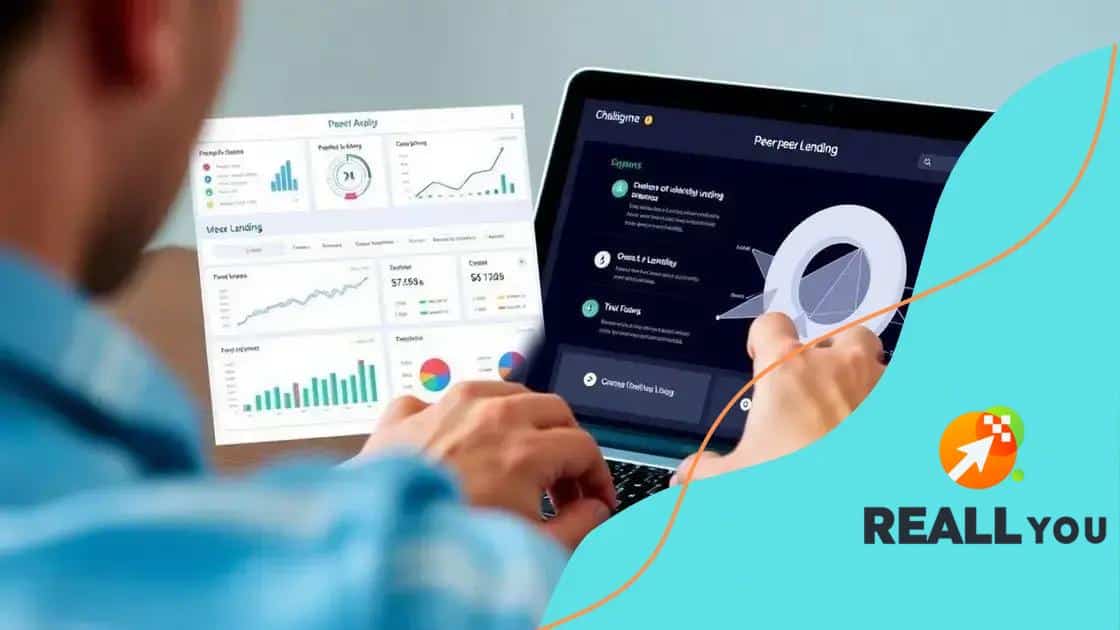How to use peer-to-peer lending as an investment strategy

Anúncios
Peer-to-peer lending is a direct borrowing and lending method where individuals lend money to each other through online platforms, offering potential high returns and diversification but also carrying risks like borrower default.
How to use peer-to-peer lending as an investment strategy could reshape how you think about your finances. Are you curious about alternatives to traditional investments? This guide will walk you through the essentials.
Anúncios
Understanding peer-to-peer lending
Understanding peer-to-peer lending is crucial for anyone considering alternative investment options. This financial model connects borrowers directly with investors, allowing individuals to lend money without the need for banks or other financial institutions.
Anúncios
The process is straightforward. Borrowers apply for loans on online platforms, and investors can fund those loans. But what makes this system appealing?
Key Benefits of Peer-to-Peer Lending
There are several advantages for both borrowers and investors:
- Lower interest rates for borrowers compared to traditional banks.
- Higher returns on investment for lenders relative to conventional savings accounts.
- Diversification of investment portfolios for individuals.
However, despite its benefits, peer-to-peer lending comes with risks. It’s essential to evaluate these carefully before diving in.
Risks to Consider
Investors should be aware of potential downsides:
- Default risk, as borrowers may fail to repay loans.
- Lack of liquidity compared to traditional investments.
- Limited regulatory oversight that can affect loan security.
By understanding both the benefits and risks, you can make informed decisions about participating in the peer-to-peer lending market.
Benefits of peer-to-peer lending investments

The benefits of peer-to-peer lending investments are attracting many investors looking for alternatives to traditional finance. This investment model provides unique opportunities that can lead to generous returns.
One of the primary advantages is the potential for high returns on your investment. In contrast to regular savings accounts, where interest rates are often low, peer-to-peer lending platforms can offer attractive rates. This makes it an appealing option for those looking to grow their wealth.
Advantages of Peer-to-Peer Lending
Here are some key benefits:
- Diversification: You can spread your investments across multiple loans, reducing risk.
- Passive income: Investors often earn consistent income from interest payments.
- Accessibility: Most platforms are user-friendly and open to all types of investors.
Understanding these benefits can help you decide if this investment strategy aligns with your financial goals.
Potential for Higher Earnings
While risk is always a factor in any investment, peer-to-peer lending often provides better returns than traditional savings options. By evaluating different loans, investors can select those with the best interest rates.
Investors should also consider the types of loans available. Secured loans, for example, may offer lower risk than unsecured ones. Assessing the risk-to-return ratio for each loan can lead to better financial outcomes.
Risks associated with peer-to-peer lending
Investing in peer-to-peer lending can be lucrative, but it’s essential to be aware of the risks involved. Understanding these risks helps you make informed decisions and protect your investments.
One major risk is the possibility of borrower default. Since you are lending directly to individuals, there is a chance that some borrowers may not repay their loans. This can lead to a loss of your investment if those borrowers fail.
Types of Risks in Peer-to-Peer Lending
Here are some common risks you should consider:
- Credit risk: Not all borrowers have the same creditworthiness, and some may pose a higher risk of default.
- Platform risk: The lending platform itself may face financial troubles or go out of business.
- Regulatory risk: Changes in laws or regulations can impact the viability of peer-to-peer lending.
It’s also important to note that peer-to-peer lending investments are less liquid than traditional investments. This means you may not be able to access your funds quickly if you need them. Consider how long you’re willing to lock your money in loans.
Mitigating Risks
To minimize risks, diversify your investments across multiple loans. This way, if one borrower defaults, the impact on your overall investment is reduced. Additionally, research potential borrowers thoroughly before lending, looking into their credit scores and repayment histories. Understanding their financial situation can guide you in making better lending choices.
How to choose a peer-to-peer lending platform

Choosing the right peer-to-peer lending platform is vital for a successful investment experience. With many options available, it’s important to consider a few key factors to ensure you make the best choice.
One of the first aspects to evaluate is the platform’s reputation. Look for platforms with good reviews and strong ratings. A well-established platform typically signifies reliability. Additionally, consider how long the platform has been operating. Longer operating times often reflect stability.
Factors to Consider
When selecting a platform, keep these factors in mind:
- Fees: Different platforms have various fee structures, so understand how fees will affect your returns.
- Investment options: Ensure the platform offers a diverse range of loans that meet your investment goals.
- Borrower vetting process: Learn how rigorous their borrower evaluation is. A strong vetting process can reduce loan defaults.
After evaluating these aspects, you can feel more confident in your selection process. Another important factor is customer support. Good platforms offer accessible customer service to help you with any issues or questions.
Security Considerations
Security is also crucial when selecting a peer-to-peer lending platform. Check if they use encryption techniques to protect your personal and financial information. Transparency is vital, so look for platforms that provide detailed information about their loan offerings and borrower performance.
By comparing different platforms based on these factors, you can ensure that your investments in peer-to-peer lending are both safe and profitable.
Strategies for maximizing returns in peer-to-peer loan investments
Maximizing returns in peer-to-peer loan investments requires strategic planning and careful decision-making. By implementing certain strategies, investors can enhance their earning potential and minimize risks.
One effective strategy is to diversify your portfolio. Instead of investing all your funds in a single loan, spread your investments across multiple loans. This reduces the risk of significant losses if one borrower defaults. You can choose loans with varying amounts, interest rates, and risk profiles.
Practical Strategies to Consider
Here are some additional strategies that can help you maximize returns:
- Invest in higher-rated loans: Consider backing loans with borrowers who have higher credit ratings. They usually have lower default rates.
- Reinvest interest payments: Use the interest you earn to purchase additional loans. This compound growth can significantly increase your overall returns over time.
- Monitor market trends: Stay informed about the peer-to-peer lending market. Economic changes can influence borrower behavior and interest rates.
Another important aspect is the importance of understanding the loan terms. Thoroughly reviewing loan agreements and interest structures can help you identify the most lucrative opportunities. Look for loans with favorable terms and competitive interest rates.
Long-Term Investment Mindset
Adopting a long-term investment mindset can also benefit your peer-to-peer lending strategy. Rather than seeking quick returns, think about sustainable growth over time. Patience can often yield better results in this type of investment.
Taking a strategic approach, along with a focus on research and diversification, can greatly enhance your success in peer-to-peer loan investments.
FAQ – Frequently Asked Questions about Peer-to-Peer Lending
What is peer-to-peer lending?
Peer-to-peer lending is a method of borrowing and lending money directly between individuals through online platforms, without the involvement of financial institutions.
What are the benefits of investing in peer-to-peer lending?
Benefits include potentially high returns, the ability to diversify investments, and the opportunity to earn passive income from interest payments.
What risks are involved with peer-to-peer lending?
Risks include borrower default, platform risk, and lower liquidity compared to traditional investments.
How can I choose a reliable peer-to-peer lending platform?
Look for platforms with good reviews, strong borrower vetting processes, transparent fee structures, and robust customer support.






